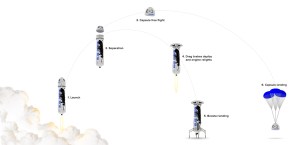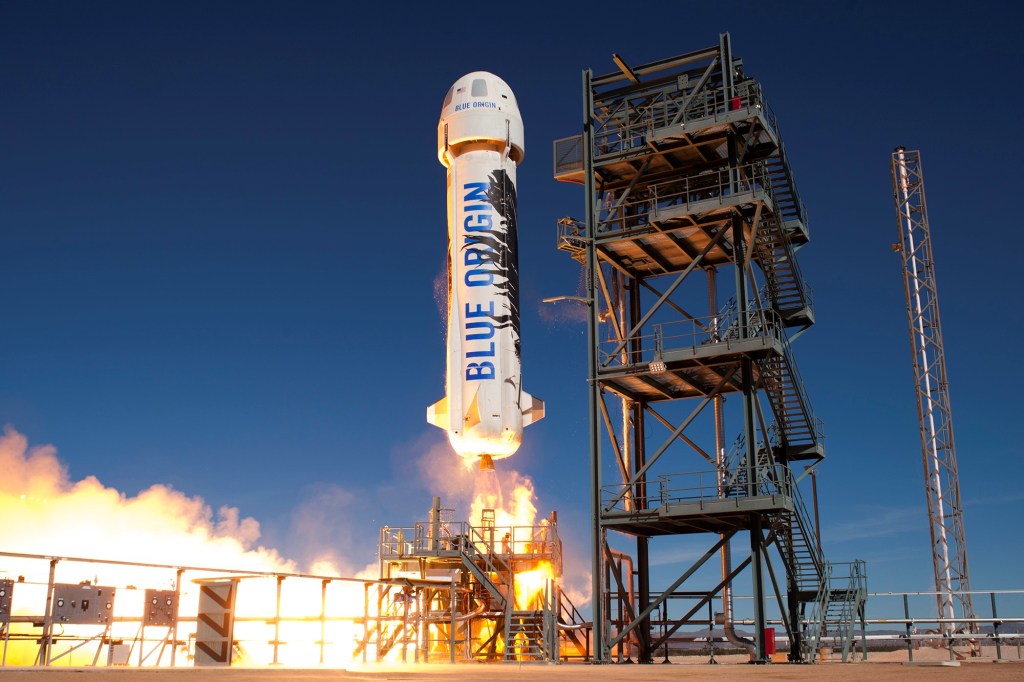Blue Origin, the rocket company started by Jeff Bezos, has partnered with NASA to fly and test technology payloads on suborbital flights with the New Shepard launch vehicle.
Bezos’ company is the sixth partner that NASA has selected through the Suborbital Reusable Launch Vehicle Flight and Payload Integration Services program. Blue Origin will compete with the other companies, including Virgin Galactic and World View Enterprises, for contracts in this program that will have a combined value of up to $45 million.
The NASA contract is the most recent milestone in Blue Origin’s fast-paced development in recent years.
Although the company was founded in 2000, Blue Origin has been notoriously secretive about their plans, progress, and technology development until recently. The company didn’t even have a detailed website until the late 2000’s. Earlier this year, they made major headlines when Bezos welcomed reporters into Blue Origin headquarters in Kent, Washington for the very first time.
Because of this lack of transparency, much of what the public has heard about Blue Origin has happened in the last year – now that the company is promoting the routine launch and recovery of the New Shepard vehicle.
Back in April, 2015, Blue Origin conducted the first developmental test flight of New Shepard. Since then, things have moved rather quickly.

In November, 2015, the company made history by completing their first landing of New Shepard after it had flown into suborbital space.
The New Shepard space capsule, which is designed to eventually carry up to six crew members into space, also came along for the ride. After the capsule reached its peak altitude of over 62 miles, it descended back to Earth with the aid of three parachutes.
Within six short months after New Shepard’s November flight, Blue Origin launched and recovered it two additional times (three times in total). Each of these tests also included a recovery of the space capsule, descending back to the ground with all three parachutes successfully deployed.

A fourth flight for the recovered New Shepard vehicle is already in the works. While a date hasn’t been announced, Bezos has mentioned that it will likely be before the end of the month.
This particular test flight will include one intentional parachute failure during the descent of the crew capsule. In his statement to email subscribers, Bezos explained the credibility of such a scenario, providing the example of the parachute failure during the Apollo 15 mission in 1971.
You might remember the Apollo 15 capsule had one parachute fail during its return to earth prompting the recovery ship USS Okinawa to radio to Worden, Irwin and Scott in the Command Module “You have a streamed chute. Stand by for a hard impact.” – Jeff Bezos, Founder of Blue Origin

During the tour given to a small number of journalists earlier this year, Bezos stated that his company plans to have their first crewed test flights in 2017 and hopes to bring their first paying passengers into space as early as 2018.
In addition to the business of perfecting reusable suborbital rockets for the purposes of research and space tourism, Blue Origin is also working with United Launch Alliance (ULA) to build a high-performance engine known as the BE-4. The BE-4 engine has been under development since 2011 and uses liquefied natural gas and liquid oxygen propellants, one of the first large engines with this combination.
BE-4 is the only engine that can fly by 2019, meeting the congressionally mandated deadline to eliminate dependence on Russian-built engines. – Blue Origin website
While the BE-4 would be used for Blue Origin’s future orbital rocket program, it could also be sold to ULA for use in their next generation rocket, the Vulcan. There are other rocket engines (like Aerojet Rocketdyne’s AR-1 engine) that could be selected by ULA for this purpose, but Blue Origin’s BE-4 is a leading contender.
In controversial remarks that later forced him to resign, former ULA executive Brett Tobey suggested that Blue Origin was the obvious, preferred provider for their next rocket engine.
Compare it to having two fiancées, two possible brides. Blue Origin is a super-rich girl, and then there is this poor girl over here, Aerojet Rocketdyne. But we have to continue to go to planned rehearsal dinners, buy cakes and all the rest with both. We’re doing all the work on both, and the chance of Aerojet Rocketdyne beating the billionaire is pretty low. Basically we’re putting a whole lot more energy into BE-4 for Blue Origin. – Former ULA Executive Brett Tobey
The past twelve months have been good to Blue Origin.
They’ve become the first company to vertically launch, land, and reuse space-bound rockets. Their BE-4 engine is slated to be flight-ready in three years’ time and could help ween the United States off of Russian-made rocket engines. They’re working with NASA to build out the research side of their business. And, if flight tests continue to go as well as they have in the past year, they could become the first private company to send tourists into suborbital space.
Of course they still have a long way’s to go a lot to prove, but Blue Origin had gone along for nearly fifteen years without many headline-catching achievements. Now, they’re making up for lost time.































Comment